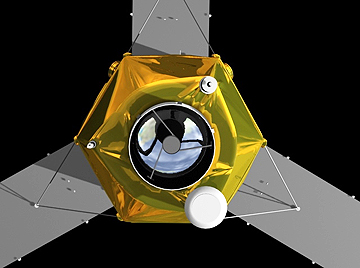The e2v CCD (Charge Coupled Device) image sensors developed under CNES contract and selected by Thales Alenia Space to equip the high-resolution (HR) optical imaging instrument, for integration into the CNES (Centre National d’Etudes Spatiales) Pleiades Earth observation satellite (which includes two e2v device types for panchromatic and multispectral imaging), have delivered a performance that exceeds the original specification.

After environmental testing, the optical and radiometric (image quality) performance of the image sensors was found to have exceeded expectations, with the Instrument
MTF (
Modulation Transfer Function) and signal to noise ratio 1.5 times better than the original specification. The 200kg, high-resolution instrument includes, for its panchromatic focal plane, five
e2v CCD98-50s, each with 6,000 pixels; therefore giving 30,000 pixels per line. In addition these CCDs have TDI (Time Delay Integration) functionality to enable them to capture high resolution images (70 cm on ground resolution) and are back-thinned to improve sensitivity. To achieve the performance requirements specified, the CCD was designed with the following features:
- A pixel size and pitch of 13μm square
- Four phase parallel transfer electrode structure, implemented in four levels of polysilicon
- Longitudinal anti-blooming structures in every pixel, optimised for back-illumination to maintain 100% fill factor — 6,000 active pixels per line, with a maximum of 20 TDI lines and selectable number of active TDI lines in flight
- 10 serial readout registers, each with an optimised output amplifier, each output therefore serving 600 pixels per line
Custom Aluminium Nitride package, with anti-reflective (AR) coated window
In common with most e2v image sensors, the
Pleiades TDI sensor is designed with back-illumination for high quantum efficiency and sensitivity. The Pleiades satellite also includes a multispectral focal plane, which uses an e2v CCD sensor type
AT71554, with the following main features:
- 4 photosensitive lines
- 1,500 photosensitive elements per line
- Pixel size 52 x 52 µm
- PRNU (Photo Response Non Uniformity) 1% r.ms
- Non-linearity: 1%
The Pleiades project is part of
ORFEO (
Optic and Radar Federated Earth Observation system), a joint French-Italian initiative by the countries' national space agencies
CNES and
Agenzia Spaziale Italiana (
ASI), marking a major technological advance in optical Earth observation systems. The two Pleiades observation satellites are scheduled for launch in early 2010 and 2011 respectively and will orbit the Earth, capturing very high resolution panchromatic and multi-spectral images from an altitude of 694km, for a period of at least five years.
Topical Tags :
Regional Tags :

